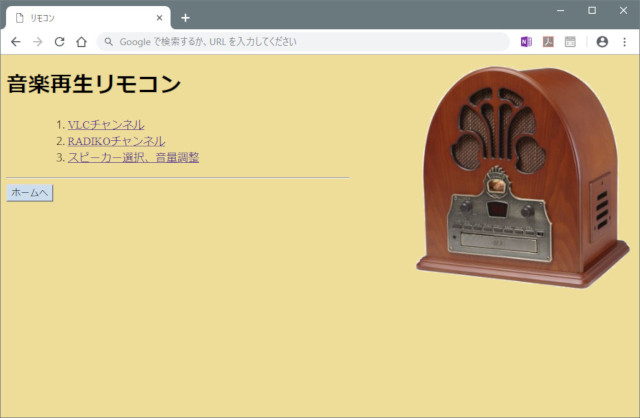
- Gmediarender audiosink audiodevice how to#
- Gmediarender audiosink audiodevice install#
- Gmediarender audiosink audiodevice android#
- Gmediarender audiosink audiodevice software#
- Gmediarender audiosink audiodevice plus#
Gmediarender audiosink audiodevice android#
This summarises and completes my previous posts on configuring a Raspberry Pi to play music streamed from another computer in the house, using Android phones as remote controls. Hopefully I can get this working on the same linux box as minidlna is running on. It looks as though the BubbleUPnPServer basically adds another, persistent and stateful, layer to the system so that an OpenHome controller (such as BubbleUPnP) tells BubbleUPnPServer what to play and it then tells the existing (plain) UPnP renderer what to do. create a playing playlist on a device and pick it up later on another device.several OpenHome Control Points (BubbleUPnP, Linn Kinsky) can be connected to the same renderer simultaneously, showing the same playlist and playback state.no need to leave the Control Point running for playlist track advance to happen.each OpenHome renderer has its own playlist.As the site says:Īn OpenHome Renderer has the following advantages over a regular UPnP AV renderer:
Gmediarender audiosink audiodevice software#
These problems are known of course, and the BubbleUPnP author has another piece of software called BubbleUPnPServer which is an OpenHome renderer.
Gmediarender audiosink audiodevice plus#
If you look at a second controller then you cannot see what is playing (it may think something else is), but on the plus side, the volume controls work on all controllers and the play/pause does as well. So if one of us sets an album playing and then goes out, the Pi doesn’t receive the instruction to play the next song. This is a pretty good solution but has some problems caused by the playlist being held on the controller (one of the phones). bubbleupnp on multiple Android phones to control the music choice.gmedia-resurrected running on the Raspberry Pi to play the music through the mini Hi-Fi.minidlna running on the media server (a nettop linux box behind the sofa).Interestingly, I tried it without the “-c pi:audio” so that the daemon ran as root and the sound quality went bad again.

You can then do “sudo service gmediarenderer start” to run gmediarenderer as a daemon there and then or reboot and it will start automatically. To make the script executable and add in all the symbolic links from the /etc/rc.x directories. $ sudo update-rc.d gmediarenderer defaults $ sudo chmod 755 /etc/init.d/gmediarenderer Start-stop-daemon -x /usr/local/bin/gmediarender -KĮcho "Usage: /etc/init.d/gmediarender " Start-stop-daemon -x /usr/local/bin/gmediarender -c pi:audio -S -f 'Raspberry' -d # Description: Start GMediaRender at boot time.

# Short-Description: Start GMediaRender at boot time Create a file /etc/init.d/gmediarenderer with the following contents: Now gmediarender is compiled and gstreamer works on the Raspberry Pi we need to get it all to start on boot.įairly standard stuff here (copied from Malte’s post in Chris’ blog). Next task is to get the gmediarender process to start on boot. One problem I’ve just noticed is that when you skip forwards a track in an album for instance then there are a few pops and clicks. I later realised that I probably didn’t actually have PulseAudio running and would need to start it with the command “pulseaudio –start” but next time I turned the Pi on to try it, PulseAudio was running and the sound from gmedia-resurrected, via gstreamer, to PulseAudio, ALSA and finally to the hardware sounded just great! How strange that adding another layer to the sound stack makes it better, not worse… # Then I realise I don't have pulseaudio itself installed.Īfter doing all of that the sound was just the same. $ gconftool-2 -a /system/gstreamer/0.10/default $ gconftool-2 -t string -set /system/gstreamer/0.10/default/musicaudiosink pulsesink $ gconftool-2 -t string -set /system/gstreamer/0.10/default/audiosrc pulsesrc

$ gconftool-2 -t string -set /system/gstreamer/0.10/default/audiosink pulsesink # Need to configure gstreamer to use pulseaudio
Gmediarender audiosink audiodevice install#
$ sudo apt-get install gstreamer0.10-pulseaudio
Gmediarender audiosink audiodevice how to#
I may post have now posted a complete cleaned up installation guide later but personally I find seeing how other people have made mistakes and worked out how to do things instructive as well. The following annotated shell transcript shows how I installed PulseAudio and configured gstreamer to use it. There’s a great article on how linux audio works which helps explain things a lot. It’s been a long time since I got into the detail of linux audio systems and it all seems to have changed. One of Chris Baume’s commenters also had problems with the audio qut.ality and suggested that directing the audio via PulseAudio fixed it. A bit more googling revealed a post from someone doing much the same as me. Having now got gmrender to compile and run on the Raspberry Pi and use gstreamer as a backend I need to fix the audio quality issues.


 0 kommentar(er)
0 kommentar(er)
